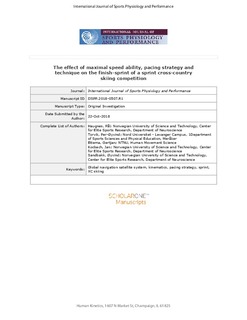The Effect of Maximal Speed Ability, Pacing Strategy, and Technique on the Finish Sprint of a Sprint Cross-Country Skiing Competition
Journal article, Peer reviewed
Accepted version

Åpne
Permanent lenke
http://hdl.handle.net/11250/2595398Utgivelsesdato
2018Metadata
Vis full innførselSamlinger
Originalversjon
10.1123/ijspp.2018-0507Sammendrag
Purpose:
The aims of this study were to investigate the contribution from maximal speed (Vmax) and %Vmax to the finish-sprint speed obtained in a cross-country (XC) sprint in the classical and skating style, as well as the coinciding changes in kinematic patterns, and the effect of pacing strategy on the %Vmax.
Methods:
Twelve elite male XC skiers performed two 80-m Vmax tests on flat terrain using the classical double poling and skating G3 techniques, followed by four simulated 1.4-km sprint time-trials, performed with conservative (controlled start) and positive (hard start) pacing strategies in both styles with a randomized order. In all cases, these time-trials were finalized by sprinting maximally over the last 80-m (the Vmax-section).
Results:
~85% of Vmax was obtained in the finish-sprint of the 1.4-km competitions, with Vmax and %Vmax contributing similarly (R2=51-78%) to explain the overall variance in finish-sprint speed in all four cases (P<0.05). The changes in kinematic pattern from the Vmax to the finish-sprint included 11-22% reduced cycle rate in both styles (P<0.01), without any changes in cycle length. A 3.6% faster finish-sprint speed, explained by higher cycle rate, was found by conservative pacing in classic (P<0.001), whereas no difference was seen in skating.
Conclusions:
The Vmax ability and the %Vmax contributed similarly to explain the finish-sprint speed, both in the classic and skating styles, and independent of pacing strategy. Sprint XC skiers should therefore concurrently develop both these capacities, and employ technical strategies where a high cycle rate can be sustained when fatigue occurs.